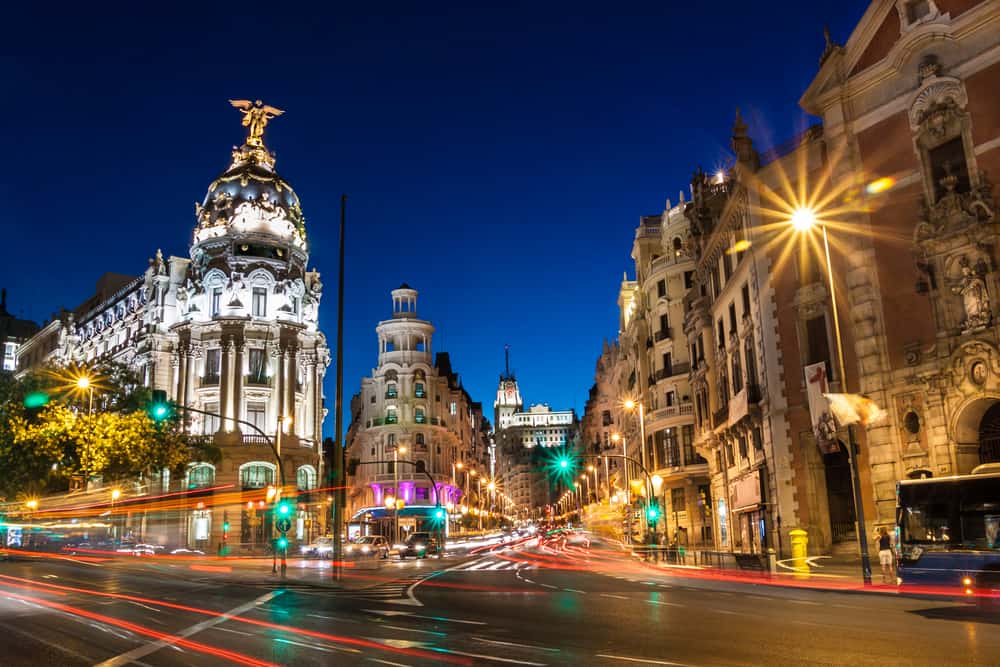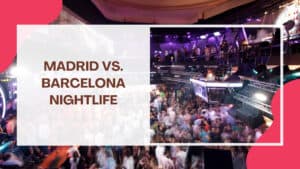Is Madrid Safe at Night? (+Tips to Staying Safe)
Yes, it’s perfectly safe to go out in Madrid at night — the city boasts one of the lowest crime index and highest safety index measures in Spain! Of course, it’s still important to remain vigilant, but you can definitely enjoy a stroll in the city during the evenings.
If you’re planning a trip to Madrid, it would be a shame to miss the city’s vibrant nightlife. There are also so many places to visit that you might not get to cover during the daytime.
It goes without saying, but even though Madrid is safe, there are still some precautions you should take to avoid getting into trouble!
In this article, you’ll get the rundown of everything you need to know to stay safe and have a good time, including:
- The safest neighborhoods in Madrid
- Areas to avoid
- Nighttime public transportation
- Top tips for staying safe.
Ready to get started?

Madrid Crime Rate
Madrid enjoys one of the lowest crime rates in the country, which is an amazing feat considering it’s also the second-largest city (by population) in the EU!
The city’s perceived crime rate hovers at around 23 out of 100 according to Numbeo. Despite being a major city, locals and tourists don’t need to worry much about serious crimes like assault or armed robbery.
You might have to keep a closer eye on your valuables, however, as theft is pretty common in the city. Given how many people are always walking about, the relatively high number of pickpocketers isn’t surprising.
In terms of districts, the city center has the highest crime rates as it is one of the most crowded areas in Madrid. However, it’s still a lot safer when compared to similar cities across the EU!
Safest Neighborhoods in Madrid
In big cities, it’s well known that some areas are safer for tourists and travelers.
While you don’t need to only stick to this list, it still provides a wide range of interesting and pleasant places to explore while still being as safe as possible.
It’s important to still be cautious even within these areas and to be respectful of the locals and your surroundings. Here are the top-rated neighborhoods in Madrid!
Salamanca and Retiro
These neighborhoods are generally upper class and considered to be very safe for tourists (although maybe a little dangerous on the wallet!).
Salamanca is perhaps the best-known neighborhood in Madrid, featuring historic buildings and boulevards, the “Golden Mile”, and many famous tourist attractions.
Retiro is Salamanca’s only competition for the title, as it’s home to Parque de El Retiro, the Prado Museum, and many popular hotels, restaurants, and other appealing attractions.
Centro
Comprised of Universidad, Sol, Justica, Cortes, Palacio, and Embajadores, Centro is just that: the center of the city!
This area has plenty of tourists and foreigners living there, including students, young workers, and families. It’s generally considered a safe area at any time, though normal precautions still apply (and it may get a little rowdy at night).
The following districts are also considered safe:
- Chamartín: upscale boutiques, fashion, business, and football fans
- Chamberí: residential area with museums, dining, tourism, and tapas
- Moncloa-Aravaca: student area with Casa de Campo park, cable car, and other attractions
- La Moraleja: an affluent residential area
- El Viso: an even more affluent area – in fact, the wealthiest neighborhood in the city
- Mirasierra: colleges, parks, cafes, and restaurants
- Conde Orgaz: residences, business centers, and pleasant parks
- Fuente del Berro: a sub-region of Salamanca, known for beautiful gardens, water features, art, public performances, and museums.
Areas to Avoid at Night in Madrid
Like in any city, there are some areas that are less safe than others.
These neighborhoods tend to have fewer foreigners, are less well-lit, and have less of a police presence. It’s a good idea to steer clear of them unless you are familiar with the area:
- Usera
- Puente de Vallecas
- Carabanchel
- Villaverde
- San Blas-Canillejas.
Overview Of Public Transportation At Night In Madrid
At night, public transportation is still available – though it may run less frequently.
While taxis and rideshare apps are generally always available, keep in mind wait times (especially for busy nights or less popular locations) as well as the higher cost of using these options.
Metro
In general, trains run from 6:00 am to 2:00 am ( with the start of the final line at 1:30 am). They usually come every two minutes during the day, and every fifteen past midnight.
Buses
The buses run normally from 6:00 am to 11:30 am. After that, the night buses – called búhos (owls) – run from 11:55 to 5:00 am. However, these have more limited coverage.
It’s very important to plan in advance and take wait times and limited frequency of public transportation into account.
Tips For Staying Safe In Madrid At Night
Stay In Well-Lit Areas
It’s generally a good idea to stay in well-lit places with plenty of people around. This makes you a less appealing target for crime or harassment.
Avoid Poorly Lit Streets
On the flip side, poorly lit areas such as side streets, alleyways, or unpopulated parks should be avoided wherever possible – especially if you’re unfamiliar with the area.
Not only are you an easier victim of crime, but you risk a higher chance of losing your way or even just feeling unsafe (which is unpleasant, of course).
Walk With A Group
Wherever possible, try and walk in a group of people. This makes you less likely to be pickpocketed or singled out and approached.
If you’re traveling alone, try and join (or even appear as you’ve joined) a group of fellow tourists – or better yet, locals!
Use Official Taxis
Taxis in Madrid are white with a red band on the front of the car and the city’s logo.
They also have a green light that turns on when free.
You should only use these taxis, and never get into an unmarked car or one that seems unsafe. There are apps and telephone numbers you can use to call a taxi if there isn’t one available:
- Free Now (mytaxi) – Telephone: +34 902 050 570
- Join Up Taxi – Telephone: +34 915 331 464
- Tele Taxi – Telephone: +34 913 712 131
- pidetaxi – Telephone: +34 915 478 200
- TxMAD – Telephone: +34 914 04 33 24
You can also use Cabify (the most popular) and Uber in Madrid.
Keep Belongings Secure
Know where all your important belongings (passport, papers, phone, wallet, etc.) are at all times, and keep them close to your body – preferably in a zippered pocket or cross-body bag.
Avoid wandering around with a large backpack or suitcase if you can help it, as it marks you clearly as new to the city.
Know Emergency Numbers
112 is the general emergency line in Spain. The operators generally speak English as well as Spanish and will be able to help you in a range of other languages as well.
It’s also a good idea to memorize or write down important numbers such as that of your host, accommodation, or emergency contacts in case your phone dies or something happens.\
Knowing how to politely ask to use a telephone couldn’t hurt either!
Trust Your Instincts
At the end of the day, go with your gut. If an area or event feels unsafe to you, there’s a good chance it may be.
Don’t do things you feel uncomfortable with, and don’t be afraid to leave a situation or change plans if something feels off.
FAQs
Is Madrid safe to walk alone at night?
In general, Madrid is safe to walk alone at night. However, normal precautions should be taken, such as sticking to populated and bright areas whenever you can.
What to be careful of in Madrid?
Though Madrid is generally a safe city, you do need to keep an eye out for pickpockets at popular tourist sights, the metro, and the airport. As always, take normal travel precautions at all times!


